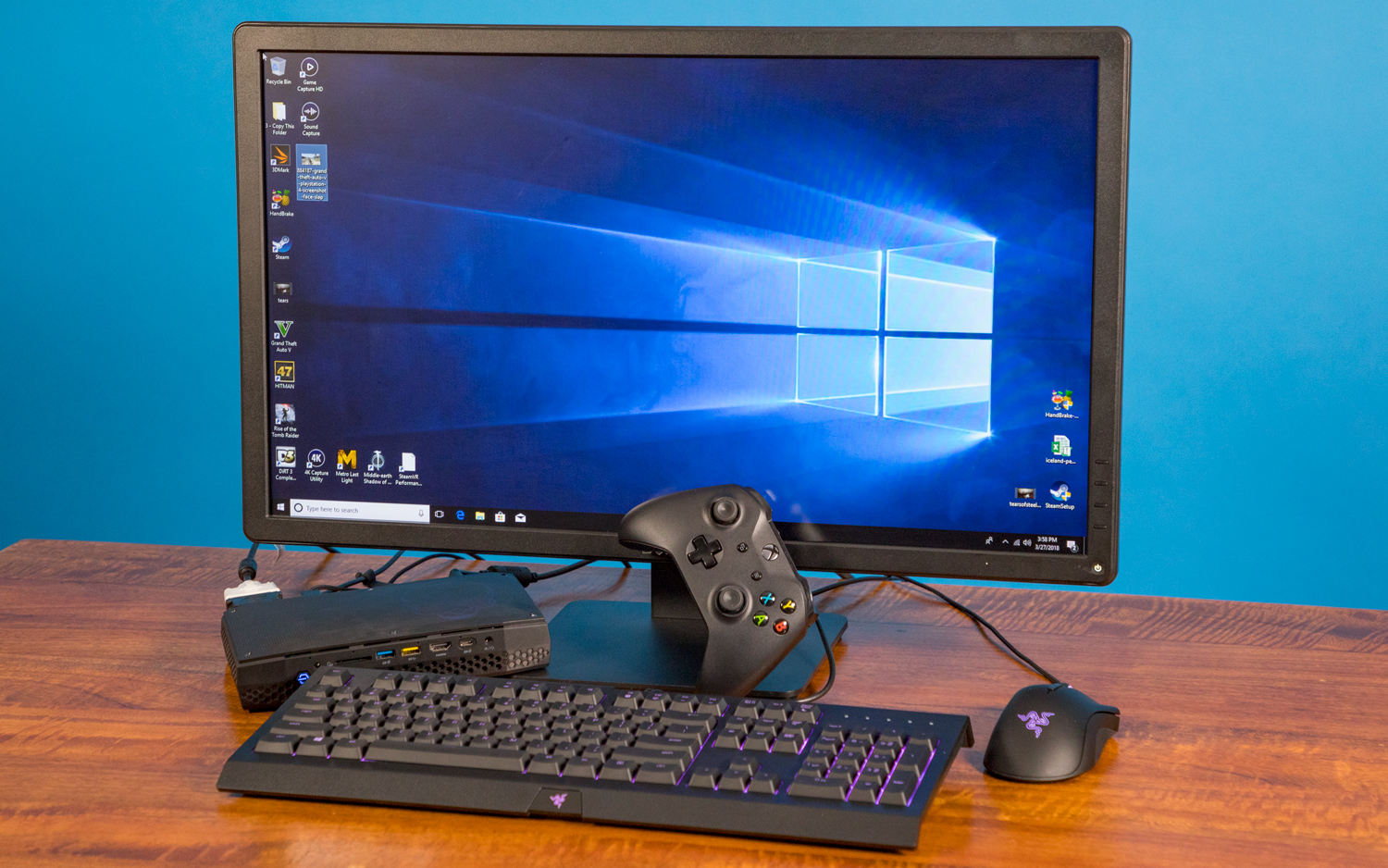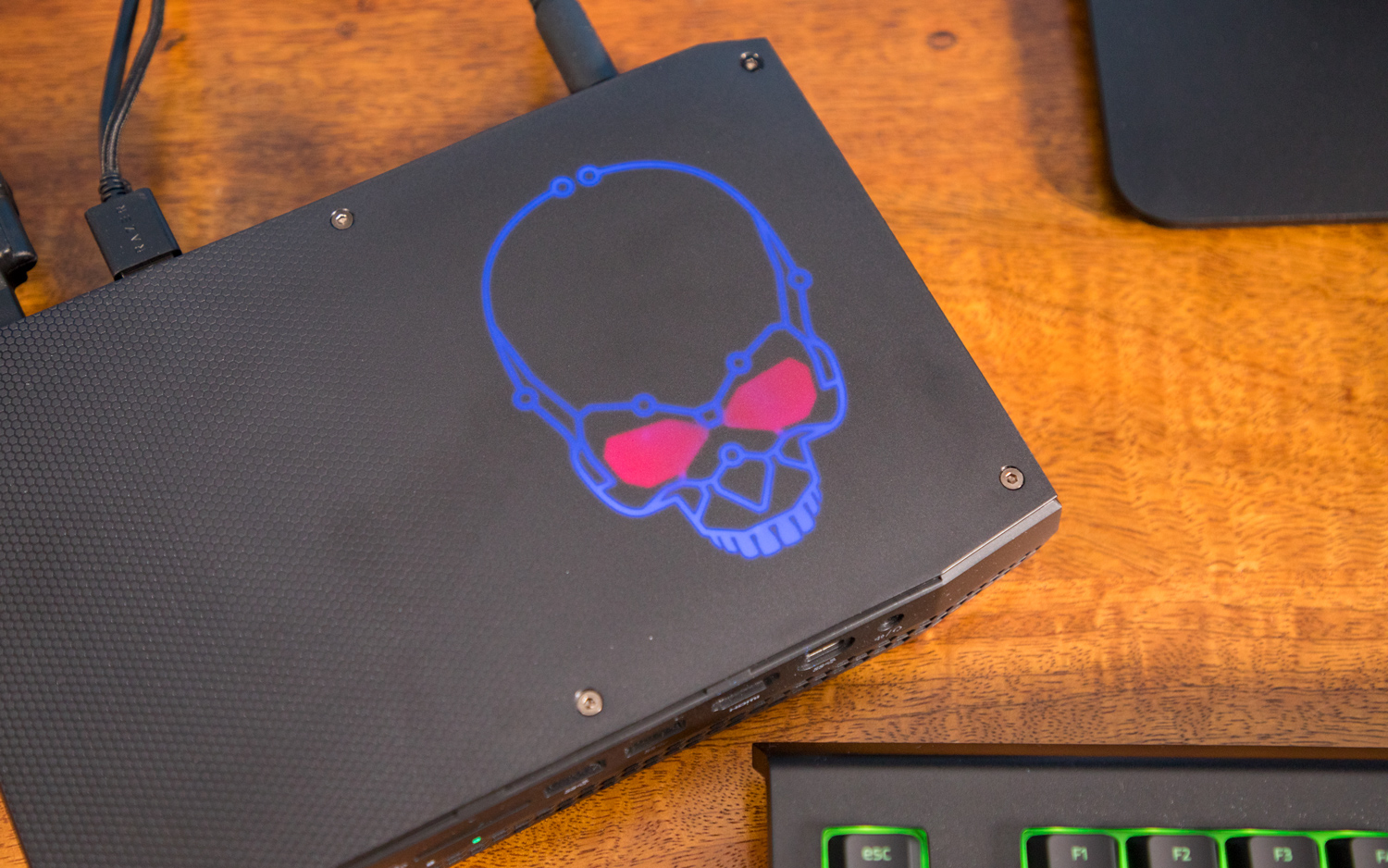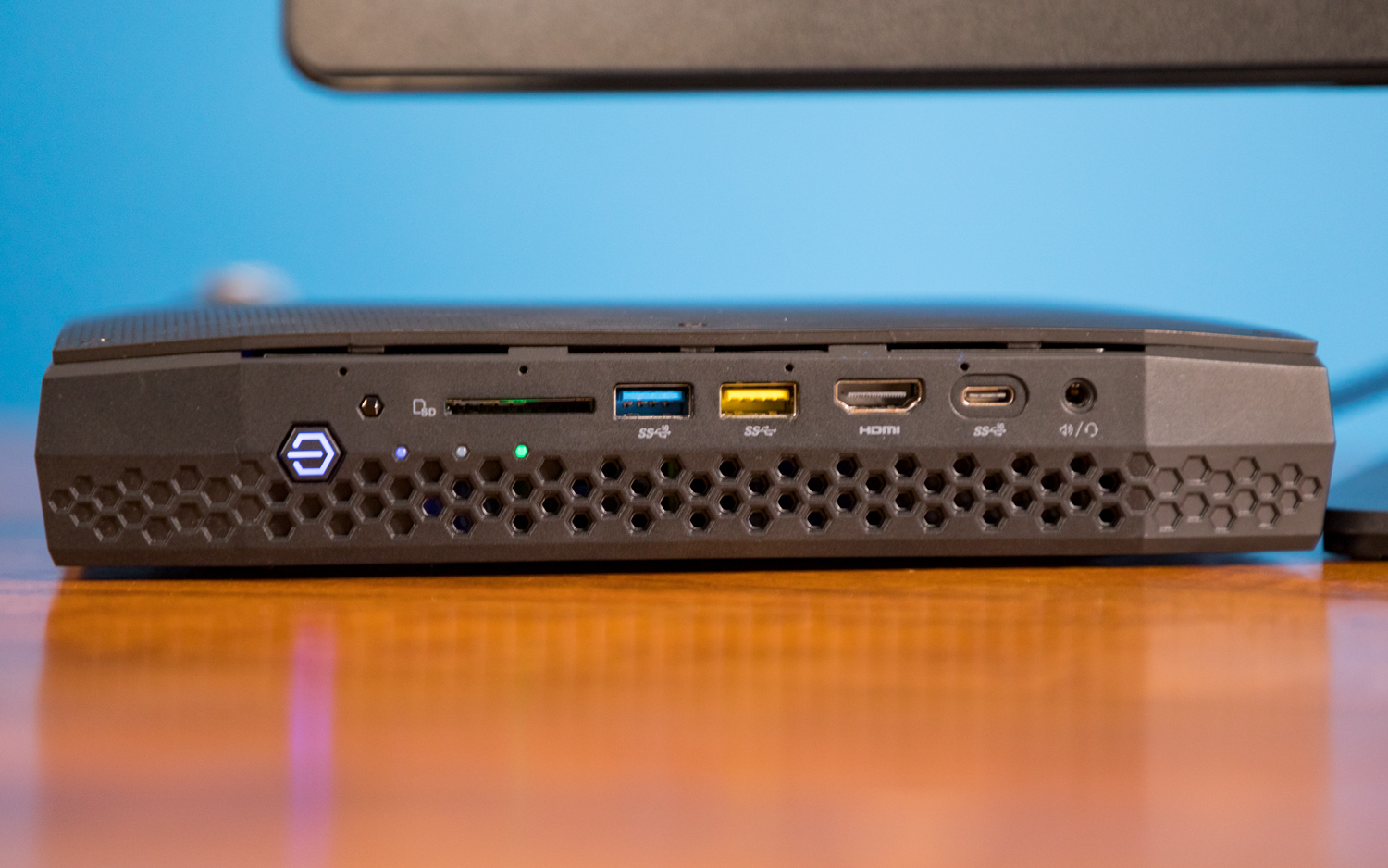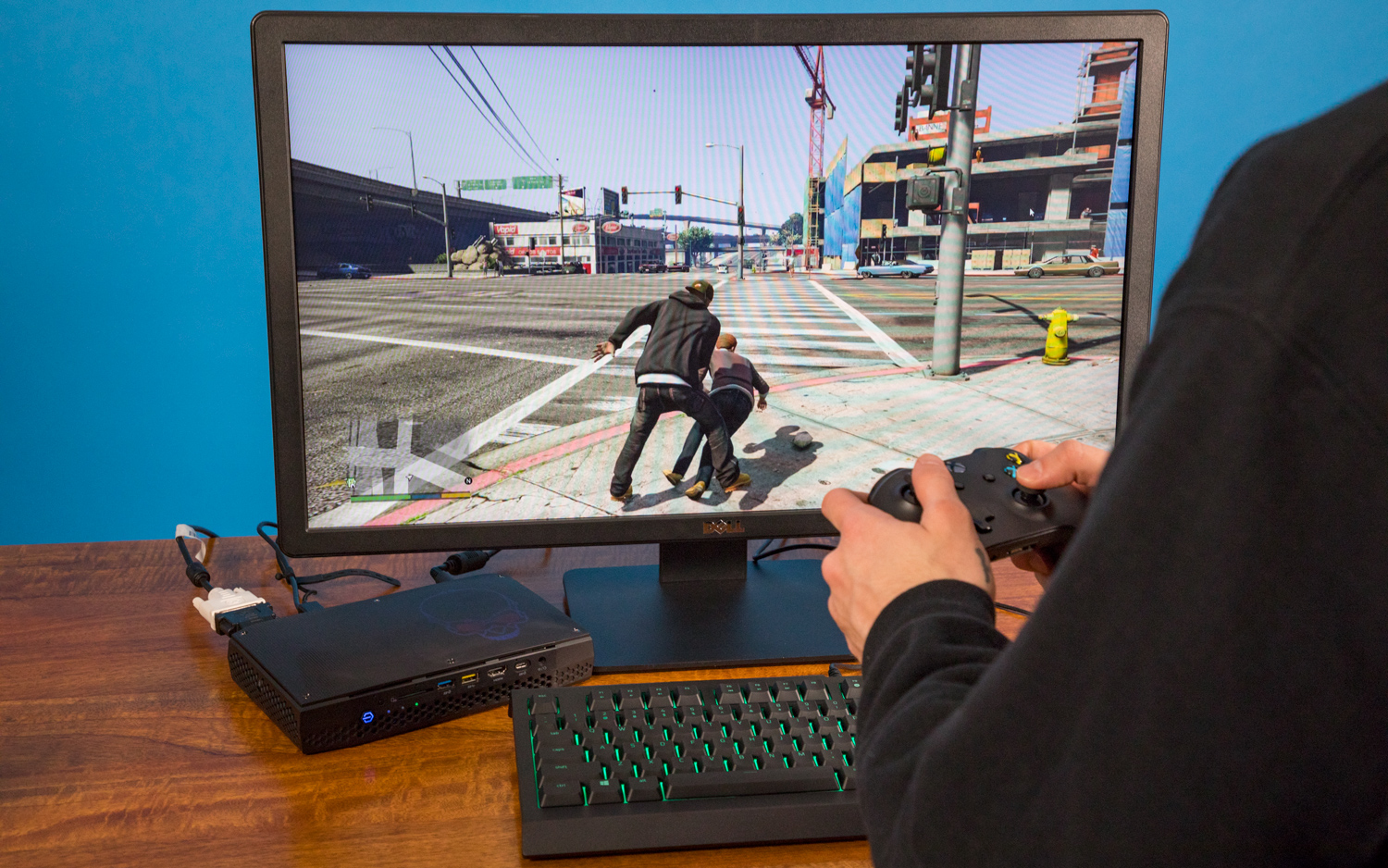Tom's Guide Verdict
The Intel Hades Canyon NUC offers impressive gaming performance for a mini PC, but it gets pricey once you add your own components.
Pros
- +
Impressive graphics performance
- +
Compact, attractive design
- +
Tons of ports
- +
Customizable RGB lighting
Cons
- -
Expensive after adding parts
Why you can trust Tom's Guide
There are a handful of gaming-capable mini PCs out there, but most are significantly compromised when it comes to performance. The Intel NUC8i7HVK (also known as the Intel Hades Canyon NUC or NUC Enthusiast 8) could be one of the first machines to buck that trend, and the best mini PC for gaming.
Powered by Intel's powerful new Kaby Lake G hybrid processor, the new NUC ($799 starting, $999 as reviewed) manages to squeeze out comparable performance to an entry-level gaming tower from a chassis that's about the size of a book. The Hades Canyon NUC's impressive power and customizable RGB lighting make it an enticing mini PC option for gamers, though it'll run you quite a bit of cash once you factor in the cost of the RAM, SSD and operating system you'll need to buy for this bare-bones PC.
Editor's Note: (March 26, 2021) We periodically update our reviews to make sure that pricing and information is up to date. Our rating and recommendation for the Intel Hades Canyon NUC review remains unchanged from when it originally published in March of 2018.
Intel Hades Canyon NUC: Design
Like Intel's previous gaming-minded NUCs, the new Hades Canyon model is a small, black brick that you can easily toss in your bag or slide into your entertainment center.

At just 8.7 x 5.6 x 1.5 inches, it's notably bigger than the Kangaroo Plus Mobile Desktop (4.9 x 3.2 x 0.5 inches) but much slimmer and shorter than the Alienware Alpha (7.9 x 7.9 x 2.2 inches). It's a fraction of the size of a game console and will barely make a dent on your desk.

The Hades Canyon looks unassuming — until you turn it on, that is. Once powered, the NUC emits a striking, skull-shaped glow out of its top panel. Using the included LED Manager app, you can customize both the skull and eyes to glow any color you like, as well as set the lights to breathe in and out or pulsate quickly.
The Hades Canyon looks unassuming — until you turn it on.

You can also tweak the colors of the PC's front-facing lights and set them to correspond with specific things, such as whether your power plug or Ethernet cord is connected. Want to disable the LEDs completely? You can do that, too. The NUC's RGB options are very robust for a PC of this size, and I appreciate that the skull is LED-based and not etched into the design like it was on the previous Skull Canyon model.
Intel Hades Canyon NUC: Ports
Despite its small size, the Hades Canyon NUC is absolutely loaded with ports. The mini PC features two USB 3.0 ports, a USB-C port, an SD card slot and a 3.5mm audio jack up front, as well as a front-facing HDMI port for easy VR setup.

In the back, you'll find four USB 3.0 ports, two Thunderbolt 3 ports, two Ethernet ports and an optical audio jack. You'll also find two mini DisplayPort 1.2 ports, as well as an HDMI port, giving you plenty of options for connecting to your monitors.
Intel Hades Canyon NUC: What's included
The Intel Hades Canyon NUC is a bare-bones system, meaning all you get out of the box is the PC's Intel Core i7-8009G/AMD Radeon RX Vega M GH hybrid chip. You'll have to supply your own memory, storage and operating system.
MORE: The Best All-in-One Computers
For the purpose of this review, Intel supplied us with a 512GB Intel 545s series SSD ($139), an Intel Optane SSD 800P ($115), two units of HyperX 8GB DDR4-3200 RAM ($94 each) and a new copy of Windows 10 ($119). Naturally, costs will vary based on what you decide to put into your NUC, but the price of those parts combined with our $999 review unit totals out to about $1,400 for a fully configured system.
Intel Hades Canyon NUC: Gaming performance
The new NUC's big calling card is its 8th-Gen Intel Core i7 with Radeon RX Vega M processor (also known as Kaby Lake G), which combines a traditional Intel CPU with discrete AMD graphics, all within a single chip.
This design is meant to provide desktop-gaming-grade performance within a mobile-size CPU, and if our time with NUC is any indication, it succeeds strongly on that front. Our NUC turned in comparable performance to what you'd get out of an entry-level, Nvidia GTX 1050 Ti-powered gaming tower, and it even handled a bit of VR.

Intel's PC ran our Hitman benchmark (1080p, max settings) at an impressive 59 frames per second, besting Lenovo's compact Legion Y720 Cube desktop (52, Nvidia GTX 1050 Ti) but falling short of our 87-fps gaming desktop average.
The NUC tied the Legion on our Grand Theft Auto V test (1080p, max settings), with both PCs turning in a highly playable 33 fps while trailing our 82-fps average.
Intel's tiny desktop can handle virtual reality, but don't expect an optimal experience. The NUC scored a 4.6 out of 11 on the SteamVR Performance Test, netting it a "medium" grade. This means it's capable of churning out VR, but not recommended for the highest-fidelity experience.
In synthetic tests, the NUC scored a 8,451 on the 3DMark Fire Strike benchmark. That puts the NUC above the Legion (6,166), but way below our 14,070 average.
Intel Hades Canyon NUC: Performance
The Intel Core i7-8809G CPU proved just as capable for everyday multitasking as it was for gaming.
The NUC netted a 17,683 on the Geekbench 4.1 overall performance test, topping the Legion Y720 (8,110; Intel Core i3-7100U) while trailing our 18,238 category average.
MORE: The Best Computers That Can Fit in Your Hand
The 512GB Intel 545s series SSD that came with our unit proved zippy, copying roughly 5GB of files in 16 seconds, for a rate of 310 MB per second. That scorches the score for the Legion's 1TB hard drive (69 MBps), but just misses our 343-MBps gaming average.
Intel Hades Canyon NUC: Configurations
The Hades Canyon NUC comes in two varieties: a $799 configuration aimed at content creators and a $999 option that's VR-ready and overclockable. Both models feature a Core i7 Kaby Lake G CPU, but the former features Radeon RX Vega M GL graphics (comparable to an Nvidia GTX 1050), while the later sports Radeon RX Vega M GH graphics (comparable to an Nvidia GTX 1060 Max Q).
The Intel NUC ships with a three-year warranty.
Intel Hades Canyon NUC: Verdict
The Hades Canyon NUC is an excellent showpiece for the potential of Kaby Lake G, offering mi-range gaming performance and respectable VR capabilities within an absolutely tiny chassis. The customizable RGB lighting is a nice added touch, and the system's plethora of ports make it ideal for command centers and living rooms alike.
However, the NUC's performance comes at a high price. Once you take the highest-end, VR-ready nook and add in your own memory, storage and operating system, you're looking at up to $1,400 in total. That's not exactly the best value, considering you can get a comparably powerful and fully featured tower, such as the Lenovo Legion Y720 Cube, for as little as $599. Still, if you're a mini PC enthusiast who doesn't mind splurging on a bare-bones system, you'll find some killer performance tucked away inside Intel's unassuming NUC.
Mike Andronico is Senior Writer at CNNUnderscored. He was formerly Managing Editor at Tom's Guide, where he wrote extensively on gaming, as well as running the show on the news front. When not at work, you can usually catch him playing Street Fighter, devouring Twitch streams and trying to convince people that Hawkeye is the best Avenger.
-
mariosalexandridis89 I am not Mike, but I am suggesting you Chuwi HiGame .It's far better than Canyon because:Reply
1.Higame has 8GB DDR4 Memory?Canyon no
2.Higame has 128GB/256GB SSD? Canyon no
3.Higame has Windows 10 OS?Canyon no

